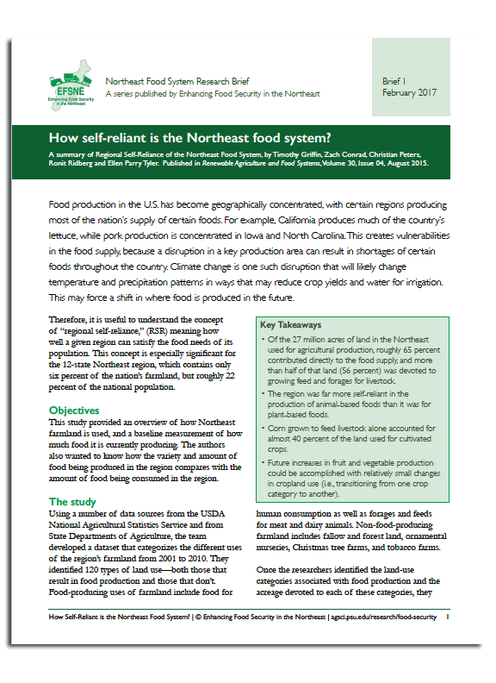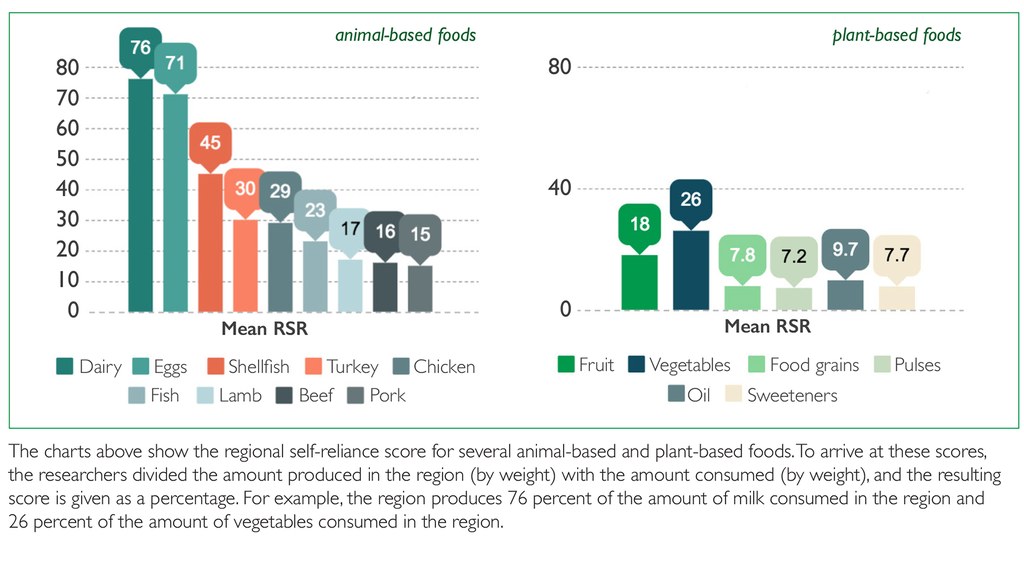A summary of Regional Self-Reliance of the Northeast Food System, by Timothy Griffin*, Zach Conrad*, Christian Peters*, Ronit Ridberg* and Ellen Parry Tyler*. Published in Renewable Agriculture and Food Systems, Volume 30, Issue 04, August 2015.

A printer-friendly PDF is available (345KB).
- Of the 27 million acres of land in the Northeast used for agricultural production, roughly 65 percent contributed directly to the food supply, and more than half of that land (56 percent) was devoted to growing feed and forages for livestock.
- The region was far more self-reliant in the production of animal-based foods than it was for plant-based foods.
- Corn grown to feed livestock alone accounted for almost 40 percent of the land used for cultivated crops.
- Future increases in fruit and vegetable production could be accomplished with relatively small changes in cropland use (i.e., transitioning from one crop category to another).
* Friedman School of Nutrition Science and Policy, Tufts University
Food production in the U.S. has become geographically concentrated, with certain regions producing most of the nation's supply of certain foods. For example, California produces much of the country's lettuce, while pork production is concentrated in Iowa and North Carolina. This creates vulnerabilities in the food supply, because a disruption in a key production area can result in shortages of certain foods throughout the country. Climate change is one such disruption that will likely change temperature and precipitation patterns in ways that may reduce crop yields and water for irrigation. This may force a shift in where food is produced in the future.
Therefore, it is useful to understand the concept of "regional self-reliance," (RSR) meaning how well a given region can satisfy the food needs of its population. This concept is especially significant for the 12-state Northeast region, which contains only six percent of the nation's farmland, but roughly 22 percent of the national population.
Objectives
This study provided an overview of how Northeast farmland is used, and a baseline measurement of how much food it is currently producing. The authors also wanted to know how the variety and amount of food being produced in the region compares with the amount of food being consumed in the region.
The study
Using a number of data sources from the USDA National Agricultural Statistics Service and from State Departments of Agriculture, the team developed a dataset that categorizes the different uses of the region's farmland from 2001 to 2010. They identified 120 types of land use--both those that result in food production and those that don't.
Food-producing uses of farmland include food for human consumption as well as forages and feeds for meat and dairy animals. Non-food-producing farmland includes fallow and forest land, ornamental nurseries, Christmas tree farms, and tobacco farms.
Once the researchers identified the land-use categories associated with food production and the acreage devoted to each of these categories, they used corresponding yield and output data from various sources to estimate how much food was produced.
They also estimated how much food was consumed by the population in the Northeast region during the same time period. They used the USDA's measure of food availability per capita, which serves as a proxy for actual consumption.
For more than 100 foods, the researchers divided the amount produced in the region with the amount consumed to arrive at the regional self-reliance score, expressed as a percentage, for each of these foods.
Findings
The study reveals quite a bit about land use in the Northeast region. From 2001 to 2010, an annual mean of 27 million acres of land in the Northeast--or about 21 percent of the region's total land area--were used for agricultural production. This includes land devoted to producing food crops, non-food crops, and animal feeds and forages, as well as woodland and "other" land (e.g., house lots, ponds, etc.).
Of this farmland, roughly 65 percent contributed directly to the food supply, and more than half of that land (56 percent) was devoted to growing feed and forages for livestock. Only about 8 percent of the region's food-producing farmland was occupied by human food crops like fruits and vegetables, food grains, oils and nuts.
As a result, the region was far more self-reliant in the production of animal-based foods than it was for plant-based foods. For example, the region produced 76 percent of the amount of fluid milk, and 71 percent of the amount of eggs consumed in the region. On the other hand, it produced only 18 percent of the amount of fruit and 26 percent of the amount of vegetables consumed.
While the authors found considerable diversity in the crops grown, they note that most of the cropland is devoted to a relatively small number of crops. Nearly 90 percent of the region's cropland was planted to corn, soybeans, wheat, alfalfa, oats, barley, potatoes and apples. Corn grown to feed livestock alone accounted for almost 40 percent of the land used for cultivated crops (not counting that used for pasture and forage crops).
The authors posit that increasing the region's self-reliance for certain foods--such as fruits, vegetables, or nuts--isn't simply a matter of increasing production of those foods, because the farmland and labor that these crops demand aren't necessarily available in the region. A more likely scenario for increasing production would entail converting existing cropland from one crop (e.g., corn) to another (e.g., melons). Given the large proportion of the region's farmland devoted to a small number of crops, some conversions would result in relatively minor changes in land use. For example, the authors note that by converting only 14 percent of the land now used for three agronomic crops (corn, soybean, and wheat), land devoted to fruit and vegetable production could be increased by 50 percent. While this certainly would reduce the region's corn, soybean, and wheat yields, such losses would be modest relative to the gains that would be realized in fruit and vegetable production capacity.
| Land area category | Regional Total (x1000 hectares)1 | Proportion of total (%) |
|---|---|---|
| Total land in farms | 10,982 | 100 |
| Livestock feed land (grazed and harvested) | 6,140 | 56 |
| Forages and field and grass seeds | 2,809 | 26 |
| Feed crops | 1,181 | 11 |
| Pastured grassland | 1,072 | 10 |
| Pastured woodland | 450 | 4.09 |
| Cropland used only for pasture/grazing | 629 | 5.73 |
| Woodland not pastured | 2,445 | 22 |
| Cropland in food production | 835 | 7.6 |
| Fruit | 107 | 0.97 |
| Commonly eaten fruit2 | 67 | 0.61 |
| Berries | 36 | 0.33 |
| Melons | 4 | 0.03 |
| Vegetables | 177 | 1.61 |
| Dark green | 4 | 0.03 |
| Starchy | 97 | 0.88 |
| Red and orange | 25 | 0.23 |
| Other vegetables | 51 | 0.46 |
| Food grains | 280 | 2.55 |
| Pulses, nuts and seeds3 | 9 | 0.09 |
| Oils4 | 258 | 2.35 |
| Sweeteners5 | 37 | 0.33 |
| Food crops grown in nurseries | <1 | <0.01 |
| Non-food cropland6 | 826 | 7.52 |
| Other land7 | 737 | 6.71 |
| 1 Hectares harvested unless otherwise specified. One hectare contains 2.47 acres. 2 All fruit except berries and melons. 3 Dry beans, dry peas, nuts and seeds. 4 Corn, soybean, canola and sunflower seed. 5 High-fructose corn syrup and glucose 6 Tobacco, Christmas trees, woody crops for paper manufacture, floriculture crops, land on which all crops failed, fallow land and conservation land 7 House lots, barn lots, ponds, roads, ditches, wasteland, etc. | ||
Conclusion
The concept of RSR is useful in understanding how well a region meets, and can meet, the food needs of its population. This is a critical first step in predicting how much food might be produced in the future under changing conditions. The research described here captures the RSR of the Northeast region from 2001 to 2010. Changes in climate, land use and availability, crop productivity, population, and/or people's food preferences will cause changes in RSR. The research provides a template for updating the findings in a timely manner and for meaningful discussion about food production in the Northeast. The complete research paper is available at: goo.gl/H0NWld. (Access may be limited.)
About the EFSNE project
The work described here is part of a larger research project called "Enhancing Food Security in the Northeast through Regional Food Systems" (EFSNE). From 2011 to 2017, the EFSNE project engaged more than 40 partners at multiple universities, non-profits and government agencies around the question of whether greater reliance on regionally produced food could improve food access in low-income communities, while also benefiting farmers, food supply chain firms and others in the food system.
EFSNE is supported by the National Institute of Food and Agriculture, U.S. Department of Agriculture, under award number (#2011-68004-30057) and is led by the Northeast Regional Center for Rural Development. Any opinions, findings, conclusions, or recommendations expressed in this publication do not necessarily reflect the view of the U.S. Department of Agriculture.
This brief was written and edited by:
- Kristen Devlin, Northeast Regional Center for Rural Development
- Kathy Ruhf, Northeast Sustainable Agriculture Working Group
- Kate Clancy, Food Systems Consultant
The authors acknowledge the contributions of Linda Berlin, University of Vermont, and Clare Hinrichs, Penn State.


